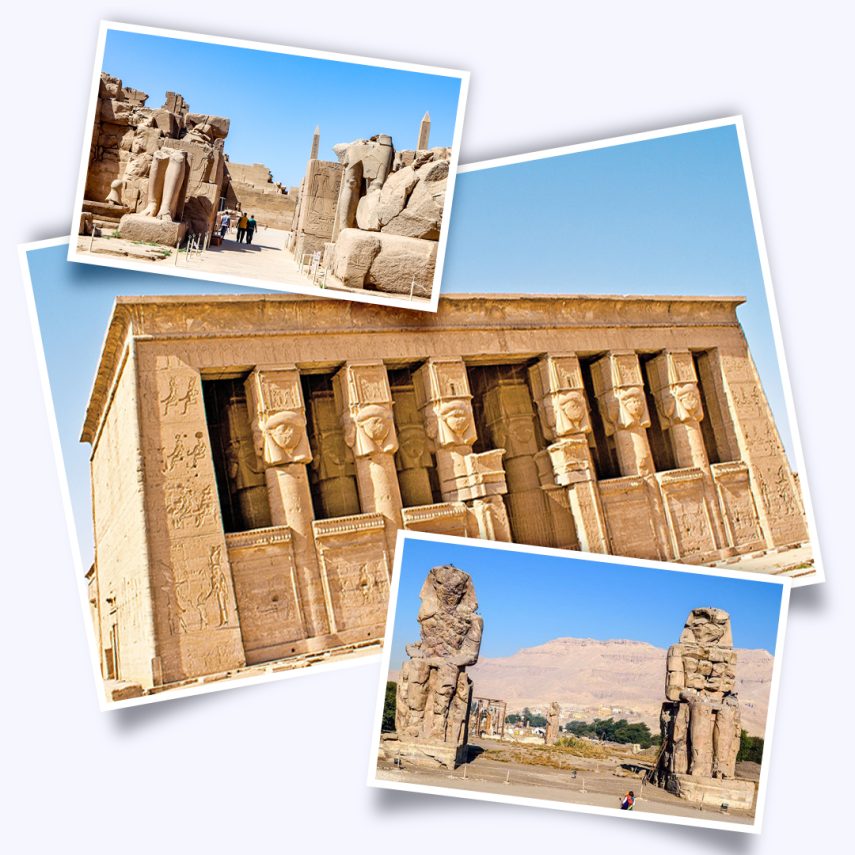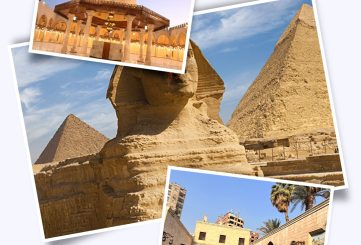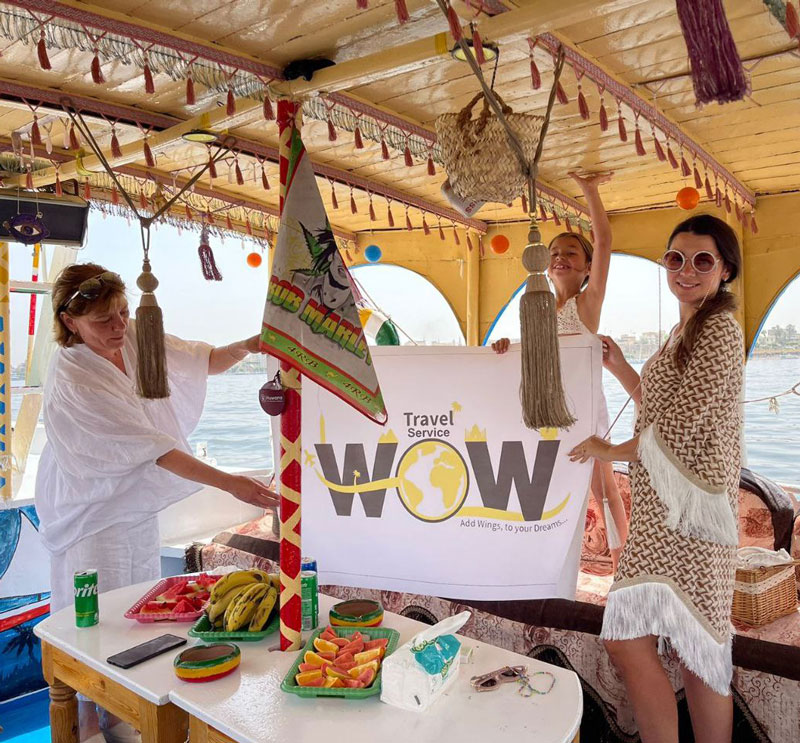Luxor and Dendera 2-Day tour from Hurghada
- $100 for 13 years and above
- $50 for children aged 6-12
- Free for children under 6 years
Day 1:
- Transfer from the hotel around 4:00 am, depending on the hotel location.
- Temple of the Goddess of Love and Beauty, Hathor (Dendera).
- City of the Living: Visit to the Karnak Temple Complex (statue of the scarab beetle, sacred lake).
- Boat trip to the other side of the Nile.
- Lunch at a riverside restaurant (buffet style).
- City of the Dead: Colossi of Memnon, visit to the Temple of Queen Hatshepsut.
- Optional boat trip to Banana Island (booked with the guide).
- Transfer to the hotel in Luxor.
Day 2:
- Optional hot air balloon flight at sunrise (booked with the guide).
- City of the Living: Visit to the Luxor Temple, walk along the Avenue of Sphinxes.
- Boat trip to the other side of the Nile.
- Lunch at a riverside restaurant (buffet style).
- City of the Dead: Visit to the Temple of Ramesses III (Medinet Habu), visit to the Nobles' Tombs.
- Boat trip to Banana Island.
- Visit to the Stone Products Factory / Perfume Factory.
- Transfer to Hurghada, arrival at the hotel around 22:00, depending on the hotel location.
*The order of activities may vary depending on the flow of tourists..
- Passport.
- Water, packed breakfast from the hotel or snacks.
- Headgear.
- Sunglasses.
- Sunscreen.
- Comfortable shoes.
- Warm clothing in winter months.
- Money for personal expenses.
- Children aged 6 and above are allowed for the hot air balloon flight.
Included:
- Transportation service.
- Transfer in a modern tourist bus with air conditioning and a toilet.
- One night in a 3-star hotel with breakfast.
- Guide - egyptologist.
- Entrance tickets.
- 2 lunches at a restaurant.
Not included:
- Additional expenses not included in the program.
- Drinks at the restaurant and hotel.
- Boat trip to Banana Island on the first day - $10.
- Hot air balloon flight - $50.
- Transportation service within Hurghada round trip for up to 6 people:
Hotels in El-Gouna, Sahel-Hashish - $10
Hotels in Soma Bay (Kempinski and Sheraton) - $15
Luxor is rightfully considered the largest open-air museum, with its name derived from the Arabic word “El Uksur,” meaning “palaces.” The River Nile divides the city into two parts: the right (eastern) bank, known as the “City of the Living,” and the left (western) bank, known as the “City of the Dead.”
We offer various excursion programs that include the most interesting landmarks, but it is impossible to cover everything within standard group tours. For those who wish to see more, we organize individual excursions in Luxor.
The Temple Complex of Dendera covers an area of approximately 40,000 square meters. Construction of the temple is believed to have begun between 2613 and 2494 BCE. The site contains structures from different eras, with the Sacred Lake, the Temple of the Goddess Isis, and, of course, the Temple of the Goddess of Love and Beauty, Hathor, being the most fascinating. Women have been visiting this temple for centuries to seek the goddess’ help with conception and childbirth.
The Karnak Temple Complex spans an area of 1.5 km by 700 m. Construction of the complex began in the 20th century BCE and lasted for 13 centuries. Karnak is the only temple consisting of ten halls and ten gateways (pylons). Notable attractions during the tours include the statue of the scarab beetle, which legend says grants wishes, and the Sacred Lake measuring 129 by 77 meters, which was used in the past for ritualistic purposes. The sacred avenue of sphinxes connects the Karnak Temple Complex to the Luxor Temple.
The Colossi of Memnon are the only surviving remnants of the temple built by Amenhotep III around 1400 BCE. The temple was completely destroyed due to an earthquake around 1200 BCE, but the colossi remained. Another strong earthquake in the 27th century BCE partially damaged the left statue, and the colossus began “singing” at dawn. However, after the restoration of the colossus in 199 CE, the singing ceased.
The Temple of Queen Hatshepsut was constructed between 1482 and 1473 BCE. The ancient name of the temple, “Djeser-Djeseru,” translates to “the holiest of the holiest.” The temple of the female pharaoh served as a place of pilgrimage, where people left requests for assistance or healing from ailments on the temple walls.
The construction of the Habu Temple of Ramesses III began with his ascension to the throne and was completed in 1156 BCE. Inside the temple’s reliefs, you can see depictions of the pharaoh’s military victories, and the fortified temple complex provided shelter for the local population during invasions.
The Necropolis of Nobles consists of over 400 tombs carved inside rocks and is usually not included in standard excursion programs. The burials took place between 1550 and 1292 BCE. Unlike the tombs of the pharaohs, the frescoes depict the daily lives of ancient Egyptians.
A hot air balloon flight is one of the most memorable experiences when visiting Luxor. The balloons ascend into the sky on the side of the city of the dead, reaching heights of up to 500 meters. From a bird’s-eye view, you will see the historical landmarks of Luxor and the River Nile in the morning sunlight.
During the visit to Banana Island, you can see not only how bananas grow but also other fruits such as mangoes and tangerines, as well as sugar cane, mint, and various spices. There is a café on the island where freshly picked bananas will be offered to you for free, and you can also pick them directly from the “banana tree” (bush) during the island walk.
The Stone Products Factory (Alabaster Factory) partly resembles a museum. During the visit, you will learn about the production technology of alabaster products and discover the differences between genuine alabaster items and imitations. If desired, you can purchase souvenirs made of genuine stone.
At the Perfume Factory, the guide will explain the techniques of oil and perfume production. The factory’s shop offers high-quality oils and oil-based perfumes for sale.








